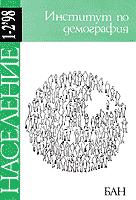ПАРАДОКС СРЕДНЕЙ ПРОДОЛЖИТЕЛЬНОСТИ ЖИЗНИ
The Life Expectancy Paradox
Author(s): Nikolay GolemanovSubject(s): Social Sciences
Published by: Институт за изследване на населението и човека - Българска академия на науките
Summary/Abstract: The World Health Organization has recognized the presence of the life expectancy paradox as a negative characteristic of the health status of a population. The author has studied its evolution since the early twenties. It has been shown that, in parallel with the falling of the infant mortality, the absolute value of the paradox has been growing smaller and smaller. The difference between the life expectancy at birth and at the exact age one year becomes a positive quantity, when the probability of death during the first year of life reaches a level of about 0,01300. Using a system of life tables, the author has also explored the evolution of the paradox in Bulgaria. Since the early twenties it has been on the decrease in two sexes and disappeared in the late eighties in female infants. But a new rise of infant mortality after 1990 has resulted in a reappearance of the paradox in female infants as well as an increase of the paradox in male infants for the first time in seventy years. According to the author, the very presence of the life expectancy paradox points at a relatively high infant mortality level and questions the value of life expectancy at birth as an integral index for the health status of a population.
Journal: Население
- Issue Year: 1998
- Issue No: 1+2
- Page Range: 61-74
- Page Count: 14
- Language: Bulgarian
- Content File-PDF

